The Master-General of the Ordnance (Swedish: Generalfälttygmästare, Gftm) was the title of a senior military official who was an artillery general and at times head of the Royal Swedish Army Materiel Administration's Artillery Department and artillery inspector. The Master-General of the Ordnance held a pivotal role from the 17th to the late 19th century, overseeing artillery administration, procurement, and maintenance. Originally known as the Riksfälttygsmästare, this position evolved to manage the Artillery Office and later the Ordnance Department of the Royal Swedish Army Materiel Administration. Until 1898, the Master-General also supervised the Swedish Artillery, but organizational changes then placed artillery units under division chiefs, while the Master-General retained authority over key artillery functions. Responsibilities included inspecting artillery exercises and overseeing weapon development, production, and equipment maintenance. The role was eventually split into separate appointments in 1937, with the Master-General heading the Swedish Army Ordnance Corps until its dissolution in 1968.
History
In Sweden, the Master-General of the Ordnance was a service designation for a member of the War College from 1675 and the head of the Artillery Office (Artillerikontoret) from 1682 to 1794 and 1807 to 1897. The Master-General of the Ordnance was responsible for the central administration of the artillery, procurement and maintenance of the army's weapons and ammunition, as well as the reserve materials of the national defence, the so-called Ordnance Storage (Tygförrådet). Previously, he was called the Riksfälttygsmästare. Between 1782 and 1865,the Master-General of the Ordnance was the head of the Ordnance Department of the Royal Swedish Army Materiel Administration, with, among others, the Deputy Chief of Ordnance and two Master of the Ordnance (Tygmästare) of regimental officer's or captain's rank as subordinates.
The Master-General of the Ordnance was until 1898 also the head of the Swedish Artillery, but in said year a change was implemented, through which the artillery regiments and corps were placed under the command of their respective army division chiefs, while the Master-General of the Ordnance retained authority over the Artillery Staff, workshops, and ordnance personnel. However, he still had the obligation to inspect the artillery exercises, and his full title was therefore the Master-General of the Ordnance and Inspector of the Artillery. He was also the head of the Artillery Department of the Royal Swedish Army Materiel Administration. As Inspector, he was responsible for the artillery in the same way as the Inspectors of the Infantry and the Cavalry, and also commanded and supervised the Swedish Army Artillery School (Artilleriets skjutskola, ArtSS).
As Master-General of the Ordnance, it was imperative for him to pay constant attention to the improvement of firearms with associated ammunition and equipment, and for that purpose at the King's request to employ or attempt to arrange for them. Furthermore, he would submit to the King for review and establishing proposals for new or changed weapon designs and more. Finally, he would oversee operations at artillery factories and ordnance establishments and oversee manufacturing of weapons, ammunition and artillery equipment for the needs of the army. To his assistant, the Master-General of the Ordnance and the Inspector of Artillery in the latter capacity had at his disposal certain personnel from the Artillery Staff. This personnel, which together formed the Artillery Inspectorate (Artilleriinspektionen), was made up partly of the head of the Artillery Staff, who also served as commander of the Swedish Army Artillery School, and partly of the chief of staff of the Artillery Inspectorate, a major of the Artillery Staff, with the subordinate Equipment Department and the Inspector's Office Department. The personnel in the departments consisted of Artillery Staff officers and commissioned officers.
The previous appointment as Master-General of the Ordnance and Inspector of Artillery was divided into two appointments on 1 July 1937: one for Master-General of the Ordnance and one for Inspector of Artillery. The Master-General of the Ordnance became the head of the Swedish Army Ordnance Corps. In 1968 the post was eliminated.
Masters-General of the Ordnance
- 1682–1692: Per Larsson Sparre
- 1692–1693: Erik Dahlbergh
- 1693–1710: Johan Siöblad
- 1710–1712: Vacant
- 1712–1715: Reinhold Johan von Fersen
- 1715–1719: Henning Rudolf Horn af Rantzien
- 1719–1724: Hugo Hamilton Hamilton af Hageby
- 1724–1728: Vacant
- 1728–1740: Fredrik Magnus Cronberg
- 1741–1754: Per Siöblad
- 1754–1757: Vacant
- 1757–1759: Thomas Cunninghame
- 1759–1761: Carl Ehrensvärd (acting)
- 1761–1765: Carl Funck (acting)
- 1766–1772: Anders Reinhold Wrangel
- 1772–1781: Reinhold Anrep
- 1781–1784: Gabriel von Spången (acting)
- 1784–1791: Carl Gideon Sinclair
- 1791–1800: Carl Ulrik Silfverschiöld
- 1800–1803: Nils Fredrik Ehrenström
- 1803–1807: Vacant
- 1807–1815: Carl von Helvig
- 1816–1821: Carl von Cardell
- 1821–1844: Crown Prince Oscar
- 1828–1834: Claes Josef Breitholtz
- 1844–1849: Axel Gustaf von Arbin
- 1849–1857: Crown Prince Charles
- 1857–1867: Fabian Wrede af Elimä
| Portrait | Master-General of the Ordnance | Took office | Left office | Time in office | Defence branch | Monarch | Ref. |
|---|---|---|---|---|---|---|---|
 | Hägerflycht, Carl HenrikMajor general Carl Henrik Hägerflycht (1817–1881) Acting | 1867 | ? | - |  Army | Charles XV | |
 | Hägerflycht, Carl HenrikMajor general Carl Henrik Hägerflycht (1817–1881) | 1872 | 14 August 1874 | 1–2 years |  Army | Oscar II | |
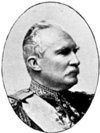 | Leijonhufvud, CarlColonel Carl Leijonhufvud (1822–1900) Acting | 18 February 1873 | July 1874 | 0–1 years |  Army | Oscar II | |
 | Carlsohn, Frans ReinholdColonel Frans Reinhold Carlsohn (1821–1899) Acting | July 1874 | August 1874 | 0 years |  Army | Oscar II | |
 | Leijonhufvud, CarlLieutenant general Carl Leijonhufvud (1822–1900) | 14 August 1874 | 12 September 1890 | 16 years, 29 days |  Army | Oscar II | |
 | Breitholtz, Edvard JuliusMajor general Edvard Julius Breitholtz (1830–1912) | 12 September 1890 | 31 December 1897 | 7 years, 110 days |  Army | Oscar II | |
 | Hamilton, JohnMajor general John Hamilton (1834–1904) | 1898 | 1902 | 3–4 years |  Army | Oscar II | - |
 | Geijer, GottschalkMajor general Gottschalk Geijer (1850–1924) | 12 August 1902 | 30 October 1903 | 1 year, 79 days |  Army | Oscar II | |
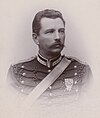 | Leth, FredrikLieutenant general Fredrik Leth (1850–1919) | 30 October 1903 | 10 April 1915 | 11 years, 162 days |  Army | Oscar II Gustaf V | |
 | Hedengren, DavidMajor general David Hedengren (1858–1946) | 1915 | 1919 | 3–4 years |  Army | Gustaf V | |
 | Sparre, LarsLieutenant general Lars Sparre (1864–1947) | 1919 | 1929 | 9–10 years |  Army | Gustaf V | |
 | Hammarskiöld, LudvigLieutenant general Ludvig Hammarskiöld (1869–1958) | 1 July 1929 | 1934 | 4–5 years |  Army | Gustaf V | |
 | Osterman, OscarMajor general Oscar Osterman (1874–1956) | 1934 | 1939 | 4–5 years |  Army | Gustaf V | |
 | Gustafsson, HalvarMajor general Halvar Gustafsson (1887–1953) | 1 October 1939 | 1949 | 9–10 years |  Army | Gustaf V | |
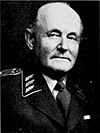 | Hedqvist, BirgerMajor general Birger Hedqvist (1894–1964) | 1 April 1949 | 1959 | 9–10 years |  Army | Gustaf V Gustaf VI Adolf | |
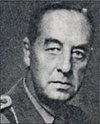 | Malm, EdwardMajor general Edward Malm (1899–1983) | 1959 | 1964 | 4–5 years |  Army | Gustaf VI Adolf | |
 | Wåhlin, StenMajor general Sten Wåhlin (1914–1981) | 1964 | 1966 | 1–2 years |  Army | Gustaf VI Adolf | |
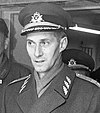 | Ljung, OveMajor general Ove Ljung (1918–1997) | 1966 | 1968 | 1–2 years |  Army | Gustaf VI Adolf |
See also
Footnotes
- After Per Siöblad's death in 1754 the office was vacant. By subservient letter of 21 October 1756, it was decided that one of the lieutenant colonel in the Artillery would be given the rank of colonel and, until further notice, conduct the tasks of the Master-General of the Ordnance. The government's choice fell on Cunninghame. Cunninghame held the post from 24 January 1757 to 10 December 1758, after which he continued as deputy until his death in 1759.
- Leijonhufvud was major general when taking office on 14 August 1874 and was promoted to lieutenant general on 14 January 1887.
- Took office as major general on 30 October 1903 and was promoted to lieutenant general on 30 September 1910.
- Took office as major general in 1919 and was promoted to lieutenant general in 1926.
- Took office as major general on 1 July 1929 and was promoted to lieutenant general on 20 January 1933.
References
Notes
- Granberg 1807, p. 289
- "Generalfälttygmästare". Förvaltningshistorisk ordbok (in Swedish). Svenska litteratursällskapet i Finland. 2016. Retrieved 12 March 2018.
- Westrin 1908, p. 905
- ^ Betänkande och förslag rörande den centrala försvarsförvaltningen. Statens offentliga utredningar, 0375-250X ; 1927:29 (in Swedish). Stockholm. 1927. pp. 29–30. SELIBR 1334799.
{{cite book}}: CS1 maint: location missing publisher (link) - "Arméledningen tillsättes 1 juli 1937". Svenska Dagbladet (in Swedish). 1937-01-07. p. A9. Retrieved 5 March 2024.
- Sveriges statskalender för året 1945 (in Swedish). Uppsala: Fritzes offentliga publikationer. 1945. p. 342.
- ^ Boёthius 1931, p. 449
- Hammarskiöld 1949, p. 438
- ^ ?a 1971–1973, p. 605
- "Telegram till "Kalmar."". Kalmar (in Swedish). No. 96. 1874-08-15. p. 1. Retrieved 22 October 2021.
- ^ Broomé 1977–1979, p. 491
- ^ "T.f. generalfälttygmästaren". Dagens Nyheter (in Swedish). No. 2904. 1874-07-14. p. 1. Retrieved 22 October 2021.
- Drakenberg 1926, p. 168
- "DEN 2 JAN. - Afsked". Svenska Dagbladet (in Swedish). No. 1 A. 2 January 1898. p. 1. Retrieved 22 October 2021.
- Hedberg 1967–1969, p. 26
- Wikland 1977–1979, p. 584
- Wikland 1977–1979, p. 584
- ?b 1969–1971, p. 427
- ^ Gillingstam 2003–2006, p. 697
- Vem är det 1942, p. 763.
- ^ Wikland 1969–1971b, p. 188
- CHC 1992–1994, p. 409
- Wikland 1967–1969, p. 429
- Wikland 1969–1971a, p. 497
- Lagerström 1968, p. 641
- Lagerström 1968, p. 1052
- Lagerström 1968, p. 598-599
- CHC (1992–1994). "Osterman, släkt". Svenskt biografiskt lexikon (in Swedish). Vol. 28. National Archives of Sweden. Retrieved 24 August 2021.
- Broomé, Bertil (1977–1979). "Carl V G Leijonhufvud". Svenskt biografiskt lexikon (in Swedish). Vol. 22. National Archives of Sweden. Retrieved 22 October 2021.
- Boёthius, B. (1931). "Thomas Cunninghame". Svenskt biografiskt lexikon (in Swedish). Vol. 9. National Archives of Sweden. Retrieved 2018-03-12.
- Drakenberg, Sten (1926). "Edvard Julius Breitholtz". Svenskt biografiskt lexikon (in Swedish). Vol. 6. National Archives of Sweden. Retrieved 22 October 2021.
- Gillingstam, Hans (2003–2006). "Sparre, släkt". Svenskt biografiskt lexikon (in Swedish). Vol. 32. National Archives of Sweden. Retrieved 24 November 2020.
- Granberg, Per Adolf (1807). English and Swedish pocket-dictionary, eller Engelskt och swenskt hand-lexikon, af P. A. Granberg. Stockholm, tryckt hos Carl Fredrik Marquard, 1807. På eget förlag. Stockholm. SELIBR 2417602.
- Hammarskiöld, Ludvig (1949). "Carl Ehrensvärd". Svenskt biografiskt lexikon (in Swedish). Vol. 12. National Archives of Sweden. Retrieved 2018-03-12.
- Hedberg, Jonas (1967–1969). "S Gottschalk A Geijer". Svenskt biografiskt lexikon (in Swedish). Vol. 17. National Archives of Sweden. Retrieved 24 August 2021.
- Lagerström, Sten, ed. (1968). Vem är det: svensk biografisk handbok. 1969 [Who is it: Swedish biographical handbook. 1969] (in Swedish). Stockholm: Norstedt. SELIBR 3681519.
- Westrin, Theodor, ed. (1908). Nordisk familjebok: konversationslexikon och realencyklopedi (in Swedish) (Ny, rev. och rikt ill. ed.). Stockholm: Nordisk familjeboks förl. SELIBR 8072220.
- Wikland, Erik (1967–1969). "Halvar Gustafsson". Svenskt biografiskt lexikon (in Swedish). Vol. 17. National Archives of Sweden. Retrieved 24 August 2021.
- Wikland, Erik (1969–1971a). "K Birger Hedqvist". Svenskt biografiskt lexikon (in Swedish). Vol. 18. National Archives of Sweden. Retrieved 24 August 2021.
- Wikland, Erik (1969–1971b). "P A Ludvig R Hammarskiöld". Svenskt biografiskt lexikon (in Swedish). Vol. 18. National Archives of Sweden. Retrieved 24 August 2021.
- Wikland, Erik (1977–1979). "Fredrik J Leth". Svenskt biografiskt lexikon (in Swedish). Vol. 22. National Archives of Sweden. Retrieved 24 November 2020.
- ?a (1971–1973). "Hägerflycht, släkt". Svenskt biografiskt lexikon (in Swedish). Vol. 19. National Archives of Sweden. Retrieved 22 October 2021.
- ?b (1969–1971). "Hedengren, släkt". Svenskt biografiskt lexikon (in Swedish). Vol. 18. National Archives of Sweden. Retrieved 24 November 2020.
- Vem är det: svensk biografisk handbok. 1943 [Who is it: Swedish biographical handbook. 1943] (in Swedish). Stockholm: Norstedt. 1942. SELIBR 10335454.